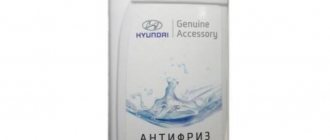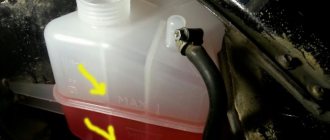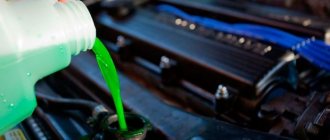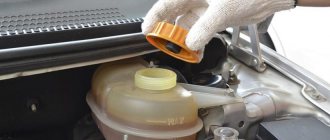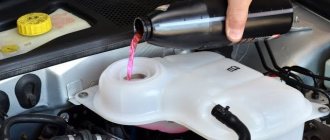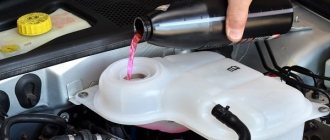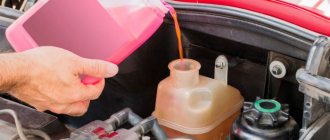Car maintenance often requires personal effort from the owner. Sometimes there is simply no service nearby that could serve and fill the necessary fluids into the car, and sometimes there is no desire to pay a lot of money for service. That’s why many motorists are interested in the features of self-service. One of the regular processes that you will need to perform while operating your car is replacing or adding antifreeze to the cooling system. This is a liquid that circulates through pipes and radiators in the peripheral system of the engine and allows us not to think about the complexities of the temperature operation of the machine.
Naturally, over time, any liquid becomes unusable and its use becomes less effective. There are different beliefs about when to change antifreeze. But the replacement process is clear and should be followed without exception. Because it is high-quality work with antifreeze that will preserve the reliability and durability of the engine. The cooling system is one of the most important peripheral elements of the power unit. Without its normal functioning, the engine will not be able to please you with reliable operation. Let's look at the features of replacing antifreeze.
How to properly add coolant to the expansion tank
First of all, you need to make sure that the car is on level ground. Only the same composition that is in the system should be added. Not all antifreezes allow mixing.
The engine is allowed to cool, after which the expansion tank cap is removed and fresh fluid is added. Distilled water can be used in small quantities if there is confidence in the tightness of the system, that is, the consumption was due to evaporation and not leakage.
After adding fluid to the normal level, the engine must be warmed up, preferably with a test drive, to operating temperature, and then cooled again. It is quite possible that air pockets will leave the system and fluid will have to be added.
How to change antifreeze and not mix old fluid with new?
To replace antifreeze in a car, you must read the vehicle's operating instructions. Below we will describe the general process of replacing coolant in any car, but there are vehicles that have individual characteristics and requirements for this process. First and foremost, UK car owners should dive into the factory manuals. Often in these brands you can find specific drain plugs that will help you completely get rid of used antifreeze. The general fluid replacement scheme is as follows:
- wait until the car has completely cooled down after use (the fluid temperature will be below 40 degrees);
- unscrew the cap of the expansion tank so that the liquid can suck in air and exit the system;
- then place containers under the cooling system plugs at the bottom of the car for subsequent draining;
- unscrew the cap on the radiator at the bottom, as well as on the engine housing (or according to the instructions);
- also unscrew the plug at the top of the radiator to allow fluid to drain normally from the thin pipes;
- wait until all the liquid has drained, do not start the engine under any circumstances, but open the heater completely (or first turn on the climate control for heating);
- when the liquid has finished draining, tighten the plugs at the bottom of the radiator and in the engine (you can leave the top radiator plug for now);
- pour the required amount of liquid through the expansion tank, do not rush, but do not pause;
- when the fluid is filled, close the radiator cap, start the engine and let it warm up the new fluid completely;
- If necessary, add more fluid to match the level indicated on the conservator reservoir.
Also, be sure to close the reservoir cap after performing all necessary checks. It often happens that the lid remains uncovered and liquid flows through it into the entire engine compartment. As you can see, the process of replacing antifreeze turns out to be quite simple; there is no need to pay money for this at the service. But if you perform a range of work in a specialized workshop, it is worth finding out the price of replacing antifreeze. There may be no point in fiddling with all these processes yourself.
Types and differences of coolants
Modern liquids for cooling systems are divided into four groups, which is associated with the complex of additives they contain.
As a rule, antifreeze of one group is poured into the system; it is highly undesirable to mix different types of them due to the possible imbalance of the additive package. Below is a list of types of antifreeze used in modern operating practice: • Carboxylate (OAT) – G12, G12+. Adsorption of the additives included in them occurs in corrosion areas. Service life exceeds five years.
• Hybrid (HOAT, Hybrid) – G11. In comparison with the former, in addition to organic inhibitors, they also contain inorganics - either silicates, or nitrites, or phosphates. They work from three to five years.
• Lobrid – G12++, G13. The organic base is combined with mineral inhibitors. They appeared relatively recently, in 2008.
• Traditional (IAT) – the least resistant, outdated coolants with a service life of up to 2 years. They are contraindicated for use in modern models.
How much antifreeze to pour into the system
When replacing coolant, follow the vehicle manufacturer's recommendations. Exact information about the volume of antifreeze in the circuit should be indicated in the service book for the car. Only minor deviations from the recommended amount of coolant are allowed. It is important that its level in the expansion tank is strictly between the Min and Max marks, which are marked on its body. Exceeding the maximum level risks the fact that when heated, the expanding liquid will create excess pressure in the circuit, which can lead to depressurization, rupture of hoses, breakdown of the radiator and other consequences. Antifreeze can also be squeezed out through the tank or radiator cap, which is extremely undesirable. Lack of coolant in the circuit is no less dangerous. If the amount of antifreeze is insufficient, the performance of the cooling system is reduced, which can lead to overheating of the engine.
You may be interested in: How much antifreeze to pour into the cooling system
You may also be interested
High-quality antifreeze is a guarantee of safe operation of your car
Antifreeze refers to the coolant necessary for the functioning of a car engine. Antifreeze allows you to cool the structural components of a car engine to the required temperature, preventing their deformation and failure. Before the invention of antifreeze, ordinary water was used as a coolant, but the water circulating in the cooling circuit tended to freeze, and when it freezes, the water increases in volume. Water expansion […]
How often should antifreeze be added?
If there is not enough coolant or its quality is lost, the temperature of the power unit will rapidly exceed the limit level. An overheated engine wears out quickly and may stall or even seize. To prevent this from happening, you should figure out how often you need to add antifreeze to your car.
Draining old refrigerant
Before changing the coolant to a new one, you need to drain the old one. First of all, you need to wait until the engine cools down. The refrigerant is under high pressure, so its boiling point increases and it does not boil. If you start to unscrew the cap, the pressure inside the expansion tank will drop to atmospheric pressure and the boiling point will also become lower, that is, the antifreeze will begin to boil and splash out. All this will happen very quickly and can lead to burns.
Coolant circulates through the radiator, engine and heater, which are connected to each other using pipes. Therefore, antifreeze must be drained from all indicated places.
We prepare containers for waste fluid in advance and place them under the radiator and engine block. It is better to cover the generator with something to protect it from getting antifreeze on it. Open the heater tap, very carefully unscrew the bolts at the bottom of the radiator and on the engine block. In some cars, access to the drain neck is blocked by a protective cover. In this case, you will need to remove it. After unscrewing the above bolts, antifreeze begins to flow out.
To speed up this process, you can open the cap on the expansion tank. When all the liquid has flowed out, we move on to the next stage - washing.
Antifreeze, what is it and what does it consist of?
What is antifreeze? This is a toxic non-freezing liquid based on ethylene glycol (less commonly, non-toxic, but more expensive propylene glycol) with the addition of water and various additives that guarantee its special properties. The additive package may contain corrosion inhibitors, compounds that prevent foaming and cavitation, and fluorescent dyes.
Due to the properties of the “coolant”, you need to know how to fill in antifreeze correctly, avoiding possible mistakes in vehicle care and instilling confidence in the smooth operation of the engine while protecting it from premature wear.
It is worth noting that the physical properties of ethylene glycol favor its use as a basic component of antifreeze also because, in addition to lowering the freezing point, it also increases the boiling point, which allows antifreeze to be poured into the system, significantly expanding the temperature range of its use.
As mentioned above, dyes are added to antifreeze, which signal the performance characteristics of the liquid; they also play the role of an indicator and, when additives are produced, they lose color intensity, thereby declaring the further unsuitability of the liquid and the need to replace it.
For information on how much antifreeze to fill, you can refer to the car’s operating manual, but best of all, go to a service station, where specialists guarantee a high-quality inspection of the cooling system and competent replacement of antifreeze, providing appropriate recommendations to the owner.
What to do after replacing the coolant
In the next few days after adding fresh antifreeze, you should periodically check the coolant level in the tank and inspect the engine compartment for the presence or absence of leaks. During this period, the amount of liquid in the expansion tank may decrease slightly; this is considered normal. The fact is that after replacing the coolant, the channels inside the cooling circuit are gradually filled. This requires a certain amount of antifreeze. When all working channels in the system are finally filled with liquid, its level in the expansion tank stabilizes and remains at the same level. As a rule, this takes 1–3 days depending on the operating mode of the vehicle.
Replacement frequency. When?
Opening most of the instructions, we are faced with advice on replacement intervals every 40,000-45,000 kilometers. However, most experts recommend changing antifreeze based not on the number of kilometers traveled, but on the basis of its annual filling into the system.
Therefore, returning to the question of where antifreeze is poured in a car, it would not be superfluous to pay attention to the material of the car’s radiator, since if it is made of aluminum, the above advice will not be superfluous at all. Although, the higher the quality of the coolant, the longer the service mileage is acceptable, which can reach up to 100,000 kilometers, because when using it, the likelihood of corrosion formations in the system is reduced.

